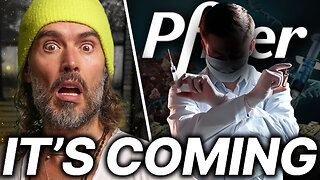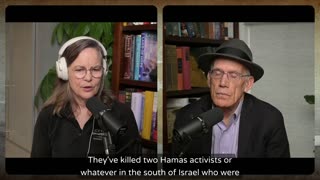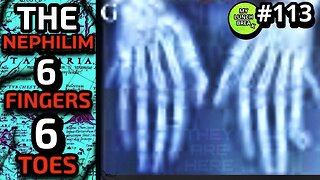Premium Only Content

Episode 2685: Audiobook - The Waters of Change: The Tiber flowed into the Amazon - Part 1
Forward
In an age where the very essence of our faith seems increasingly under siege, it is vital to return to our roots and reaffirm the truths that have sustained the Catholic Church through centuries of trials and tribulations. This book seeks to explore the complex interplay of tradition and modernity, highlighting the journey from the liturgical richness of the Traditional Latin Mass to the challenges posed by contemporary influences. Through this exploration, we aim to shed light on the necessity of preserving the Church’s sacramental life and theological integrity, resisting the tide of modernism and syncretism that threatens to dilute the faith.
As we delve into the chapters ahead, we will examine the pivotal figures and events that have shaped our understanding of the Catholic faith. We will reflect on the enduring wisdom of saints and the teachings of the Church, reminding ourselves that our mission is not merely to adapt but to evangelize to proclaim the eternal truths of the Gospel with clarity and conviction. May this book serve as a clarion call to all faithful Catholics to engage with their heritage, reclaim their identity, and champion the cause of the Traditional Latin Mass as a means of preserving the beauty and sanctity of our faith.
Introduction
The Catholic Church stands at a crossroads. As we navigate an increasingly complex and fragmented world, we find ourselves grappling with questions of identity, belief, and the very essence of what it means to be Catholic. In recent decades, the forces of modernism and cultural relativism have infiltrated the Church, leading to a re-examination of traditions once thought immutable. This book aims to provide a thorough exploration of this profound transformation, tracing the flow of ideas from the liberal currents of the Rhine countries to the heart of Rome, and ultimately to the Amazonian regions, where syncretism threatens to redefine the faith itself.
In this work, we will explore the historical context that has shaped the Church's liturgical landscape, particularly focusing on the impact of the Second Vatican Council. We will delve into the responses of key figures, including Archbishop Marcel Lefebvre, who stood as a bulwark against the erosion of tradition. Through their unwavering commitment to the Traditional Latin Mass, they demonstrated that the richness of our liturgy need not be compromised to engage with contemporary cultures.
As we journey through the pages of this book, we will highlight the dangers of abandoning our roots and the imperative for a return to the sacred traditions that have nourished the faith of countless generations. Our exploration will serve as a reminder that the essence of the Catholic faith is not found in adaptation but in the unwavering proclamation of truth—a truth that has the power to transform lives and illuminate the path to salvation.
Dedication
This book is dedicated to those who have courageously defended the rich heritage of the Catholic faith, especially:
Bishop Bernard Tissier de Malloray, whose steadfast commitment to the principles of Archbishop Lefebvre has inspired many to embrace the beauty of the Traditional Latin Mass.
Archbishop Marcel Lefebvre, a visionary leader whose tireless efforts to preserve the integrity of the Catholic liturgy and doctrine serve as a guiding light for all who seek to uphold the Church's teachings.
Fr. John Brucciani, whose pastoral care and unwavering dedication to the spiritual needs of the faithful exemplify the heart of the Catholic priesthood and remind us of the importance of fidelity to tradition.
May their examples encourage us all to strive for a deeper understanding of our faith and to embrace the richness of our Catholic heritage as we navigate the challenges of our time.
Chapter 1: The Waters of Change
"For there will come a time when people will not tolerate sound doctrine but, following their own desires and insatiable curiosity, will accumulate teachers and will stop listening to the truth and will be diverted to myths." - 2 Timothy 4:3-4
For those that are not familiar with the book titled: The Rhine Flows into the Tiber: A History of Vatican II written by Ralph Wiltgen is a detailed historical account of the Second Vatican Council (1962-1965). It presents the council as a battleground between traditionalists and progressives within the Church, focusing on how the latter faction managed to steer the council’s direction.
Here’s a high-level overview:
Title Symbolism: The title refers to the influence of European bishops, particularly from Germany (the Rhine region), over the council's decisions, which eventually flowed into the heart of the Catholic Church (symbolized by the Tiber River, which runs through Rome).
Key Themes:
Clash Between Conservatives and Progressives:
Wiltgen portrays Vatican II as a theological and political struggle. The progressives, especially bishops from Europe, sought to modernize Church practices and teachings, while traditionalists tried to maintain established doctrines.
Council Procedures and Strategy:
The book dives into the inner workings of the council, explaining how progressives gained control of key commissions and were able to shape the outcomes of the discussions. The traditionalists, particularly those from Italy and other conservative regions, were often outmaneuvered.
Influence of the Media:
Wiltgen argues that the media played a significant role in amplifying the voice of the progressive faction, often presenting their views as representing the entire Church.
Impact on Church Doctrine and Liturgy:
The book explores how the reforms instituted during and after Vatican II led to changes in liturgy (e.g., the introduction of the vernacular Mass) and a shift in the Church’s approach to issues like ecumenism, religious freedom, and relations with non-Christian religions.
Book Perspective:
Wiltgen is critical of many of the changes introduced by Vatican II. He argues that the council was swayed too much by modernist tendencies and that some of its outcomes led to confusion and disunity within the Church.
Legacy of Vatican II: The book also delves into the aftermath of the council, discussing how the reforms affected the Church and how some viewed Vatican II as a break from Catholic tradition.
This book remains a significant read for those studying Vatican II, especially from a traditional Catholic perspective. It provides insights into the complex political dynamics of the council and is critical of the progressive changes that emerged from it.
Chapter 2: The Rise of the Rhine Countries' Influence
“Do not be conformed to this world, but be transformed by the renewal of your mind, that you may prove what is the will of God, what is good and acceptable and perfect” - Romans 12:2
This passage serves as a timeless warning against compromising the faith in the name of cultural accommodation. Rather than conforming to the spirit of the age, the Church is called to be a beacon of truth and holiness, grounded in the timeless doctrines and liturgy passed down from the Apostles.
In tracing the transformation of the Catholic Church from the steady current of tradition to the rapids of modern experimentation, we find ourselves at the source of a river that would reshape Catholic thought and practice in ways previously unimaginable. This river, flowing from the Rhine countries of Northern Europe Germany, France, Belgium, and the Netherlands would pour its waters into the mighty Tiber, the symbol of conservative Rome, before eventually meandering toward the far reaches of the Amazon, where liturgical inculturation would threaten to mix Catholicism with paganism.
The Metaphor of Three Rivers
The story of the Church’s transformation can be aptly described using the metaphor of three rivers: the Rhine, the Tiber, and the Amazon. Each river represents not merely a geographical location but an intellectual and spiritual force that reshaped the landscape of the Church, often in ways that disturbed the natural harmony of its centuries-old traditions.
The Rhine symbolizes the rise of liberalism and modernism in the Church. It is a fast-moving, restless river, emblematic of the theological ferment that surged through Northern Europe in the mid-20th century. The Rhine’s waters carried with them a radical departure from the tradition-bound mindset that had guided the Church for centuries. No longer content with the established ways of liturgy, theology, and practice, the Rhine bishops and theologians sought to break free from what they viewed as the stale, rigid forms of worship and thought.
The Tiber, flowing through Rome, represents the conservatism of the Church, rooted in apostolic tradition and the enduring authority of the Magisterium. As the Rhine’s waters sought to mingle with the Tiber, the resulting current would clash with Rome’s cautious and often resistant stance toward rapid change. Rome had always been the bulwark of doctrinal continuity, but the forces unleashed by the Rhine would challenge that steadfastness.
Finally, the Amazon symbolizes the modern syncretism that we see today a movement which seeks to accommodate the Catholic faith to the indigenous and pagan rituals of the Amazon region. This third river, symbolizing inculturation, threatens to dissolve the sacrificial nature of the Mass and the unique truths of the faith into a fluid and relativistic form of spirituality. The Amazonian push for cultural accommodation could never have gained traction without the theological and liturgical shifts initiated by the Rhine theologians.
The Pre-Vatican II Era: The Calm Before the Storm
Before the Second Vatican Council, the liturgical life of the Church was centered around the Traditional Latin Mass. The Mass, as celebrated in its Tridentine form, was a ritual steeped in reverence and mystery, its roots stretching back centuries. The priest offered the Holy Sacrifice facing the altar, leading the faithful in a solemn act of worship that mirrored Christ’s own offering on the Cross. The use of Latin, the universal language of the Church, symbolized the unity of the faithful across cultures and nations. The laity, though less visibly active, participated deeply in the mysteries through prayer and meditation.
The Church’s theological foundations were also firm, built on centuries of scholastic thought, particularly the works of St. Thomas Aquinas. The doctrines of the faith were understood as unchanging truths, revealed by God and handed down through the apostolic tradition. The idea that doctrines could evolve or that liturgical practices could be significantly altered was, to most Catholics, unthinkable.
However, beneath the surface, tensions were building. The intellectual climate in Europe was changing, and many theologians and bishops, particularly in the Rhine countries, began to feel that the Church was out of step with modern society. They viewed the rigidity of the liturgy and the strict adherence to dogma as obstacles to the Church’s mission in the modern world.
The Rise of the Rhine Theologians: Pushing for Modernist Reforms
The Rhine countries Germany, France, Belgium, and the Netherlands became fertile ground for a new kind of theology, one that sought to reconcile the Church with the modern world. The leading figures in this movement, such as Karl Rahner, Hans Küng, and Cardinal Josef Frings, began to advocate for radical changes in the Church’s liturgy, theology, and pastoral practice.
These theologians were deeply influenced by the intellectual currents of their time, particularly existentialism, phenomenology, and historicism. They argued that the Church needed to engage with modern philosophy and adapt its teachings to the changing cultural and social landscape. For them, the Traditional Latin Mass was a relic of a bygone era, unsuited to the needs of modern Catholics. The emphasis on mystery and sacrifice, they argued, made the Mass inaccessible to ordinary people, particularly in the rapidly changing world of the 20th century.
One of the central ideas promoted by the Rhine theologians was the concept of "active participation" of the laity in the liturgy. This idea was based on a misunderstanding of the Church’s liturgical heritage. While participation in the Mass had always been understood as a spiritual participation, the Rhine theologians redefined it to mean physical and vocal participation. They argued that the faithful needed to be more visibly involved in the liturgy through responses, readings, and lay ministries in order to feel truly connected to the Mass.
Liturgical Experimentation: Breaking with Tradition
The push for liturgical reform soon followed. The Rhine theologians sought to simplify the liturgy and make it more accessible to the modern Catholic. They argued that the use of Latin was a barrier to understanding and that the rigid ceremonial structure of the Traditional Latin Mass alienated the laity. This drive for simplicity and accessibility led to the creation of the Novus Ordo Mass, a liturgy that would de-emphasize the sacrificial nature of the Mass in favor of a more communal celebration.
One of the most significant changes proposed by the Rhine theologians was the idea of the priest facing the people (versus populum) during the Mass. This innovation shifted the focus of the liturgy from God to the community. The traditional posture of the priest, facing the altar and leading the people in prayer, symbolized the priest’s role as a mediator between God and man. By turning the priest to face the congregation, the Rhine theologians transformed the Mass into a dialogue between priest and people, rather than a sacrifice offered to God.
Relaxing Dogmatic Boundaries
Theological innovation did not stop at liturgical reforms. The Rhine theologians also pushed for a relaxation of strict dogmatic boundaries, arguing that the Church needed to be more pastoral and less dogmatic in its approach to modern issues. Figures like Hans Küng questioned long-standing doctrines, particularly those related to the infallibility of the Pope and the authority of the Magisterium.
This push for pastoral flexibility led to a theological relativism that would have far-reaching consequences for the Church. The clear distinctions between truth and error, orthodoxy and heresy, began to blur as theologians and bishops sought to accommodate modern sensibilities. In their desire to make the faith more palatable to modern society, the Rhine theologians opened the door to doctrinal confusion and a loss of liturgical and theological unity.
The Waters that Would Divide the Church
As the Rhine waters flowed toward the Tiber, the Church would soon face an era of unprecedented upheaval. The ideas championed by the Rhine theologians—active participation, liturgical experimentation, and the relaxation of doctrinal boundaries would leave a lasting mark on the Church, leading to the fractures and divisions we see today. The story of the Rhine’s influence is one of a Church caught between the timeless truths of the faith and the pressures of modern society. It is a cautionary tale of what happens when the Church’s tradition is compromised in the name of progress.
Chapter 3: Vatican II - The Turning Point
"For there shall be a time when they will not endure sound doctrine, but according to their own desires, they will heap to themselves teachers, having itching ears" - 2 Timothy 4:3
This passage captures the essence of the crisis that emerged from Vatican II: the desire to conform the Church to the spirit of the age, rather than preserving the timeless truths of the Catholic faith.
The Second Vatican Council (1962–1965) marked one of the most significant turning points in the history of the Catholic Church. Convened by Pope John XXIII, the Council aimed to address the challenges posed by modernity, with the desire to "open the windows of the Church" to the world. What transpired, however, was a deep clash between two factions: the conservative bishops, loyal to the traditional doctrine and liturgy of Rome, and the liberal prelates of the Rhine countries Germany, France, Belgium, and the Netherlands who sought to modernize the Church. In particular, the crafting of Sacrosanctum Concilium, the document on liturgical reform, became the battleground that would eventually lead to the creation of the Novus Ordo Mass, fundamentally changing the Church’s liturgical life and theological focus.
The Role of Vatican II: A Church at a Crossroads
Vatican II was called at a time when the Church was facing immense pressure to adapt to the rapidly changing world. The horrors of two world wars, the rise of secularism, and the growing influence of modern philosophical movements such as existentialism and relativism left many questioning whether the Church could continue to speak authoritatively to the modern mind. Pope John XXIII, in convening the Council, hoped to offer a pastoral response to these issues, while reaffirming the Church’s core teachings. But the Council quickly became a forum for debate between those who wanted to preserve the integrity of Catholic tradition and those who believed that the Church needed to redefine itself in a more modern, approachable light.
From the outset, it became clear that the Rhine bishops would dominate the direction of the Council. Theologians such as Karl Rahner, Hans Küng, and Yves Congar, who had been advocating for liturgical and doctrinal reform for years, were well-prepared to take center stage at the Council. They were supported by key prelates, including Cardinal Josef Frings of Germany, Cardinal Suenens of Belgium, and Cardinal Léger of Canada. Their vision was to open the Church to a more dynamic engagement with the modern world, and they saw the liturgy as the primary vehicle for this transformation.
The Conservative Resistance: A Defense of Tradition
Opposing the Rhine coalition were the conservative bishops, primarily from Italy, Spain, and Latin America, along with a small but significant group of theologians from other regions who stood for preserving the Traditional Latin Mass and the doctrinal authority of the Magisterium. These bishops viewed the Mass as the heart of Catholic worship, and they feared that any significant change to the liturgy would lead to a dilution of the faith.
They argued that the Mass, as handed down through centuries of tradition, was not just a cultural artifact, but the sacrificial offering of Christ on the Cross. The ad orientem posture of the priest, facing the altar, symbolized the priest’s role as intermediary between God and man, leading the faithful in worship. The Latin language, far from being a barrier to understanding, was a sign of the Church’s unity and universality. Moreover, the mystery and reverence that characterized the Traditional Latin Mass were seen as essential for fostering a sense of the sacred in the liturgy.
Yet, despite their strong convictions, the conservative bishops struggled to match the intellectual and organizational force of the Rhine alliance. The Rhine bishops were well-organized and had the backing of leading theologians, which allowed them to shape the discussions and direction of the Council with remarkable effectiveness.
The Rhine Bishops and Sacrosanctum Concilium: Crafting Liturgical Reform
The most significant battle between the conservative and liberal factions took place over the drafting of Sacrosanctum Concilium, the Council’s document on the liturgy. For the Rhine bishops, the liturgy was the most visible and central expression of the Church’s life, and thus, the ideal starting point for reform. Their goal was to simplify the Mass, make it more accessible to the laity, and ensure that the faithful were actively engaged in the celebration.
This was a profound shift from the Traditional Latin Mass, which placed greater emphasis on the priest’s sacrificial role and the transcendence of God. The laity’s participation in the Traditional Latin Mass was primarily spiritual, with the faithful joining in the sacrifice through prayer and contemplation. For the Rhine bishops, however, this passive participation was no longer sufficient. They argued that the people needed to be more visibly and audibly involved in the liturgy through responses, readings, and singing.
The resulting document, Sacrosanctum Concilium, called for a series of reforms that would drastically reshape the Catholic liturgy. The most significant changes included:
The Introduction of the Vernacular: For centuries, Latin had been the universal language of the Church, uniting Catholics across the world in a common tongue. The Rhine bishops argued that the use of the vernacular in the liturgy would allow for greater understanding and participation by the laity. While the conservatives had hoped to preserve Latin as the primary language of the Mass, the final document allowed for the vernacular to be used in most parts of the liturgy.
The Reorientation of the Priest: The ad orientem posture, in which the priest faced the altar, symbolized the priest leading the people toward God. The Rhine bishops pushed for a change to versus populum, in which the priest faced the congregation. This shift was intended to make the Mass more of a communal meal than a sacrificial offering. However, conservatives feared that this change would obscure the sacrificial nature of the Mass and transform it into a mere celebration of community.
Active Participation: One of the most revolutionary ideas in Sacrosanctum Concilium was the emphasis on "active participation" by the laity. The document stated that the faithful should not be mere spectators at the liturgy, but should actively engage in the prayers, responses, and even some liturgical roles. While active participation had always been understood in a spiritual sense through prayer and devotion the Rhine bishops redefined it to mean visible, vocal participation in the liturgy.
The conservative bishops, though opposed to these changes, were ultimately unable to prevent the passage of Sacrosanctum Concilium. The Rhine alliance had successfully framed the reforms as a necessary step toward modernizing the Church and engaging with the world. By presenting the changes as pastoral rather than doctrinal, the Rhine bishops managed to win over many undecided members of the Council.
The Creation of the Novus Ordo Mass: The Triumph of the Rhine
The most concrete result of Sacrosanctum Concilium was the creation of the Novus Ordo Mass, introduced by Pope Paul VI in 1969. This new form of the Mass reflected the vision of the Rhine bishops, incorporating many of the changes they had advocated for at Vatican II. The use of the vernacular became widespread, the priest now faced the congregation, and the laity were given a more prominent role in the liturgy.
For traditionalists, the Novus Ordo represented a break with the past. The Traditional Latin Mass had been celebrated for centuries, with only minor revisions. It had been the source of countless saints' spiritual lives and had fostered a deep sense of reverence and awe for the Real Presence of Christ in the Eucharist. The Novus Ordo, by contrast, was seen as a product of modernity—an attempt to make the Mass more palatable to contemporary sensibilities at the expense of the sacred and transcendent elements of worship.
Many traditional Catholics expressed concerns that the changes in the liturgy would lead to a loss of faith among the laity. The emphasis on community and participation over sacrifice and mystery seemed to diminish the profound reality of the Eucharist as the true Body and Blood of Christ. Furthermore, the rapid implementation of the changes caused confusion and disorientation among many Catholics, who had grown accustomed to the stability and solemnity of the Traditional Latin Mass.
The Liberal Triumph: The Aftermath of Vatican II
In the aftermath of Vatican II, the Rhine bishops' vision largely triumphed. The Novus Ordo became the standard form of the Mass worldwide, and many of the reforms they had advocated for were implemented across the Church. However, the Rhine alliance's success came at a significant cost.
The years following Vatican II were marked by a period of liturgical experimentation and theological confusion. The clear boundaries between truth and error that had once characterized Catholic theology were now blurred as theologians and bishops sought to accommodate modern ideas. The Rhine bishops' emphasis on pastoral sensitivity often led to a relaxation of doctrinal standards, as evidenced by the rise of theological relativism in the post-conciliar era.
Many traditional Catholics, feeling alienated by the changes, sought refuge in the Traditional Latin Mass. Figures such as Archbishop Marcel Lefebvre became prominent voices in defense of the traditional liturgy and doctrine. Lefebvre famously refused to accept the liturgical reforms of Vatican II, leading to his eventual excommunication. However, his movement, the Society of St. Pius X, continues to be a refuge for those who seek the unchanging traditions of the Church.
Chapter 4: The Tiber’s Conservative Resistance
"The gates of hell shall not prevail against it" - Matthew 16:18
The Traditional Latin Mass, preserved by the traditionalist movement, continues to be a beacon of light in a Church seeking to navigate the turbulent waters of modernity.
The story of post-Vatican II Catholicism can be understood as the interplay of two rivers: the Rhine, representing the liberal reformers of Northern Europe who pushed for sweeping changes during the Council, and the Tiber, symbolizing the heart of Rome, where the traditionalist voices of the Roman Curia sought to temper those changes with a sense of continuity. After the Second Vatican Council, the Church found itself at a crossroads. On one side stood the Rhine bishops, advocating for a modernization of the Church’s liturgy, theology, and engagement with the world. On the other side stood the Tiber, which represented the defenders of tradition, struggling to maintain the integrity of the Church’s time-honored doctrines and practices.
This chapter explores the immediate aftermath of Vatican II, highlighting the conservative resistance that arose within the Vatican, as well as the birth of the Traditionalist Movement, which coalesced around figures such as Archbishop Marcel Lefebvre and the Society of St. Pius X (SSPX). As we delve into this period, we see that the resistance to the modernist trajectory of the Rhine did not come from a place of obstinance, but from a profound commitment to the unchanging truths of the Catholic faith.
The Tiber: Rome’s Struggle to Balance Change and Tradition
In the wake of Vatican II, the Roman Curia the central governing body of the Church was tasked with implementing the changes prescribed by the Council while also maintaining the continuity of tradition. This was no small task. The Council had unleashed a wave of enthusiasm for reform, particularly in the area of the liturgy, which was to be simplified, celebrated in the vernacular, and oriented toward active participation by the laity. The Traditional Latin Mass, which had been the standard for centuries, was now replaced by the Novus Ordo, or the new Mass, introduced by Pope Paul VI.
Pope Paul VI, though sympathetic to the reforms, was also deeply concerned about the unity of the Church. He understood that the liturgical changes could potentially cause confusion and division among the faithful, and he sought to balance the progressive spirit of the Council with the need for doctrinal stability. In his 1969 Apostolic Constitution, Missale Romanum, which promulgated the Novus Ordo, Paul VI attempted to reassure Catholics that the new Mass was in continuity with the Tradition of the Church. He stated:
"In faithful obedience to tradition, the Sacred Council declares that Holy Mother Church holds all lawfully acknowledged rites to be of equal right and dignity; that she wishes to preserve them in the future and to foster them in every way."- Sacrosanctum Concilium
Despite these reassurances, the traditionalist wing of the Church remained uneasy. Many felt that the changes in the liturgy were not merely external, but that they signaled a deeper shift in theology one that prioritized modern sensibilities over the eternal truths of the faith. This concern was only exacerbated by the subsequent theological confusion that arose in the post-conciliar period, as some theologians and bishops, emboldened by the spirit of reform, began to push the boundaries of doctrinal orthodoxy.
The Rise of Traditionalist Resistance: Archbishop Marcel Lefebvre
At the forefront of the traditionalist resistance was Archbishop Marcel Lefebvre, a French prelate who had been a missionary in Africa and a staunch defender of the Traditional Latin Mass. Lefebvre had participated in the Second Vatican Council, but he became increasingly disillusioned with the direction it was taking. He viewed the changes in the liturgy and the rise of ecumenism as a betrayal of the Catholic faith. In Lefebvre’s eyes, the Church was abandoning its role as the guardian of divine revelation in favor of compromise with the modern world.
In 1970, Lefebvre founded the Society of St. Pius X (SSPX), an organization dedicated to preserving the Traditional Latin Mass and resisting the reforms of Vatican II. The SSPX quickly grew in popularity, attracting priests and laity who were dismayed by the changes in the Church. Lefebvre argued that the Novus Ordo Mass lacked the reverence and theological clarity of the Traditional Latin Mass, and he feared that the new liturgy, with its emphasis on active participation and the use of the vernacular, diminished the sacrificial nature of the Mass.
Lefebvre’s resistance to the liturgical reforms was rooted in a broader critique of the theological trends emerging in the post-Vatican II Church. He believed that the Council had opened the door to modernist errors, particularly in the areas of religious liberty and ecumenism. In his view, these new approaches undermined the Church’s traditional teaching that salvation is found only through Jesus Christ and the Catholic Church.
Lefebvre’s critique was not without merit. In the years following Vatican II, many Catholics became confused about the Church’s teachings on essential matters of faith, such as the nature of the Eucharist, the authority of the Pope, and the role of the Church in the world. Some theologians began to promote a relativistic approach to theology, suggesting that the truths of the faith could change in response to the needs of the modern world. This led to a crisis of faith and identity for many Catholics, who struggled to reconcile the new teachings with the unchanging truths they had been taught.
Pope Paul VI: A Pontificate Torn Between Reform and Tradition
Pope Paul VI found himself in a difficult position. On one hand, he was committed to implementing the reforms of Vatican II, which he believed were necessary to engage the modern world. On the other hand, he was deeply concerned about the growing division within the Church. He famously remarked:
"The smoke of Satan has entered the Church through some fissure." Homily on the Ninth Anniversary of His Coronation, June 29, 1972
This statement reflected his fear that the spirit of rebellion and experimentation that had taken hold in some quarters of the Church was leading to chaos and disintegration. Pope Paul VI attempted to strike a balance by promoting the reforms while also affirming the continuity of the Church’s teachings and practices. However, his efforts were often met with resistance from both sides: the liberals who wanted more radical changes, and the traditionalists who saw the reforms as a betrayal of the faith.
Pope John Paul II: The Defender of Tradition Amidst Reform
With the election of Pope John Paul II in 1978, the Church entered a new phase of its post-conciliar history. John Paul II, a man of deep spirituality and intellectual rigor, sought to bridge the divide between the reformers and the traditionalists. While he continued to implement the liturgical and theological reforms of Vatican II, he was also a staunch defender of the doctrinal integrity of the Church.
John Paul II was deeply concerned about the rise of theological relativism in the post-conciliar Church, and he made it his mission to reaffirm the timeless truths of the faith. In his encyclical Veritatis Splendor (1993), he addressed the crisis of moral and doctrinal confusion that had taken hold in the Church:
"There can be no true freedom apart from or in opposition to the truth." - Veritatis Splendor
This encyclical was a direct challenge to the modernist tendencies that had emerged after Vatican II, which often sought to downplay or relativize the Church’s teachings in the name of pastoral sensitivity. John Paul II made it clear that the Church’s mission is to proclaim the truth of the Gospel in its fullness, without compromise.
At the same time, John Paul II was also sympathetic to the Traditionalist Movement, recognizing that many Catholics felt alienated by the changes in the Church. In 1988, he issued the Apostolic Letter Ecclesia Dei, in which he expressed his desire for reconciliation with the Society of St. Pius X and other traditionalist groups. He acknowledged the legitimate concerns of traditionalists and expressed his hope that the Church could find a way to preserve the richness of the Traditional Latin Mass while also embracing the spirit of Vatican II.
The Legacy of the Traditionalist Movement
The Traditionalist Movement, led by Archbishop Lefebvre and the SSPX, remains one of the most significant expressions of resistance to the changes of Vatican II. While the SSPX was excommunicated in 1988 after Lefebvre ordained bishops without papal approval, the movement has continued to grow, and the Traditional Latin Mass has seen a resurgence in recent years, especially under the papacy of Pope Benedict XVI, who in 2007 issued the Motu Proprio Summorum Pontificum, allowing wider access to the Traditional Latin Mass.
The enduring appeal of the Traditionalist Movement can be traced to its unwavering commitment to the unchanging truths of the faith. In an era marked by confusion and division, many Catholics are drawn to the clarity, reverence, and continuity of the Traditional Latin Mass. Archbishop Lefebvre’s warning against the dangers of modernism has proven prophetic, as the Church continues to grapple with the theological and liturgical disunity that emerged in the wake of Vatican II.
Chapter 5: Rome’s Concessions and the Spread of Modernism
"Do not be conformed to this world, but be transformed by the renewal of your mind, that you may prove what is the will of God, what is good and acceptable and perfect." - Romans 12:2
This exhortation serves as a reminder to the Church that, despite the pressures to adapt and conform to the world, the true mission of the Church is to proclaim the truth of Christ in all its fullness, without compromise. The concessions made by Rome to the progressive forces within the Church have led to a crisis, but the call to faithfulness remains, and the traditionalist movement continues to uphold the timeless teachings and liturgical practices that have sustained the Church for centuries.
In the aftermath of Vatican II, the conflict between the traditionalist Tiber and the progressive Rhine continued to shape the future of the Catholic Church. The conservative resistance led by the Roman Curia began to erode as the Church moved into an era of rapid change. Despite the initial efforts by the Curia and traditionalist leaders to maintain the Church’s doctrinal integrity, the spirit of reform, which had been ignited by the Rhine bishops, spread throughout the global Church, creating what many traditional Catholics viewed as a crisis of identity.
This chapter explores how, despite the conservative stance taken by key figures such as Pope Paul VI and Pope John Paul II, the Church’s post-Vatican II journey saw increasing concessions to the progressive forces within the Church. As the liturgical reforms of Vatican II became entrenched, a new theological approach inculturation emerged as a way to adapt the Catholic faith to various cultural contexts. This trend was especially evident in Latin America, where liberation theology and a focus on social justice took hold, reshaping Catholic practice in radical ways.
The Erosion of Conservative Resistance
In the years immediately following Vatican II, the Roman Curia continued to issue documents and guidelines aimed at ensuring that the Council’s reforms were implemented in a way that preserved the continuity of Catholic tradition. For example, Pope Paul VI emphasized the need for reverence and dignity in the liturgy, insisting that the changes to the Mass, particularly the use of the vernacular and the simplification of certain rites, did not represent a break with tradition but rather a development within it. In his encyclical Mysterium Fidei (1965), Paul VI warned against any innovations that might undermine the doctrine of the Real Presence in the Eucharist:
"Let everyone be quite certain that none of these things detracts in any way from the dogma of the Real Presence of Christ in the Eucharist as it has been taught by the Catholic Church." - Mysterium Fidei
However, as time passed, the spirit of reform that had been championed by the Rhine bishops became more influential. Many dioceses around the world began to interpret the Council’s teachings in ways that deviated from the traditional understanding of the faith. In some places, the liturgical changes were seen not merely as a reform, but as an opportunity for experimentation. As a result, practices such as the use of lay ministers, the reception of Communion in the hand, and the elimination of Latin from the Mass became common, much to the dismay of traditional Catholics.
The Tiber’s resistance to these developments began to erode as more bishops, theologians, and clergy embraced the spirit of Vatican II, which they interpreted as a mandate for innovation and adaptation. The result was a growing disconnect between the official teachings of the Church and the lived reality of Catholic communities, where liturgical and theological confusion became increasingly widespread.
The Rise of Inculturation: Adapting the Faith to Cultures
One of the most significant post-Vatican II developments was the rise of inculturation, the idea that the Catholic faith should be adapted to the cultural contexts in which it is practiced. This concept was grounded in the belief that the Church should engage with the world and allow its teachings and practices to be shaped by local cultures. Proponents of inculturation argued that this approach would make the faith more accessible and relevant to people in different parts of the world.
The push for inculturation was particularly strong in Latin America, where many theologians and clergy sought to integrate elements of local cultures into Catholic worship and teaching. This movement was seen as a way to make the faith more appealing to the indigenous populations, many of whom had been marginalized or oppressed by colonial powers. Inculturation, they argued, would allow the Church to embrace diversity and affirm the dignity of all people, regardless of their cultural background.
However, traditional Catholics viewed inculturation with suspicion. They feared that adapting the faith to local cultures would lead to syncretism, the blending of Catholicism with non-Christian religious practices. These concerns were particularly acute in Latin America, where elements of pagan rituals and beliefs were sometimes incorporated into Catholic worship. The result, traditionalists argued, was a watering down of the faith, in which the universal truths of Catholicism were subordinated to cultural relativism.
The Influence of Liberation Theology and Social Justice
Another major influence in Latin America during this period was liberation theology, a theological movement that sought to address the plight of the poor and oppressed by emphasizing the Church’s role in promoting social justice. Liberation theologians, such as Gustavo Gutiérrez and Leonardo Boff, argued that the Church must be actively engaged in the struggle for economic and political liberation, particularly in societies marked by oppression and inequality.
While liberation theology was initially met with enthusiasm by many in the Church, particularly in Latin America, it quickly became a source of controversy. Critics, including Pope John Paul II, argued that liberation theology risked reducing the Gospel message to a mere political ideology. They feared that the emphasis on social justice, while important, was overshadowing the Church’s primary mission of proclaiming the salvation of souls. In his 1984 Instruction on Certain Aspects of the "Theology of Liberation", the Congregation for the Doctrine of the Faith, under the leadership of Cardinal Joseph Ratzinger, warned against the dangers of liberation theology:
"One cannot use Marxist analysis in order to give it a Christian meaning, for its materialist elements stand in opposition to the Christian conception of man and society." Libertatis Nuntius
Despite these warnings, liberation theology continued to gain traction, particularly among those who saw the Church’s traditional teachings as insufficient to address the pressing issues of poverty and injustice. In many parts of Latin America, the Church’s focus on social justice became so prominent that it led to a radical reorientation of Catholic practice, with less emphasis on the sacraments and doctrinal orthodoxy, and more on political activism.
Rome’s Concessions to Progressivism
As the influence of inculturation and liberation theology spread throughout the global Church, Rome found itself under increasing pressure to concede to the demands of the progressive wing. Though traditionalist movements like the Society of St. Pius X (SSPX) had emerged in resistance to these trends, their influence was limited, and the majority of Catholic bishops and clergy aligned themselves with the progressive vision of the Rhine prelates.
The papacy of Pope John Paul II is particularly noteworthy in this regard. Though John Paul II was a staunch defender of orthodox doctrine and sought to rein in some of the excesses of liberation theology, he also made significant concessions to the progressive forces within the Church. For example, his embrace of interfaith dialogue and his participation in ecumenical gatherings, such as the 1986 Assisi meeting, were seen by many traditionalists as signs that the Church was drifting away from its commitment to proclaiming the uniqueness of Christ and the necessity of membership in the Catholic Church for salvation.
Moreover, under John Paul II’s pontificate, the Church continued to promote the idea of inculturation, particularly in regions like Africa, Asia, and Latin America. While John Paul II sought to ensure that inculturation did not lead to the compromise of Catholic doctrine, his willingness to embrace cultural adaptation left many traditionalists concerned that the Church was conceding too much to the spirit of the age.
-
 7:33:46
7:33:46
Phyxicx
14 hours agoRaid & Rant with the FF14 Guild on Rumble! Halo Night just wrapped up! - Go Follow all these great guys please! - 2/15/2025
102K2 -
 10:42:19
10:42:19
Reolock
16 hours agoWoW Classic Hardcore (LVL 60) | RAID DAY | Rumble FIRST HC Raid
62.9K4 -
 3:10:03
3:10:03
Barry Cunningham
13 hours agoTRUMP WEEKEND BRIEFING! MORE WINNING...MORE LEFTIES LOSING IT!
48.9K33 -
 2:20:09
2:20:09
Tundra Tactical
12 hours ago $2.25 earnedIs Trumps Executive Order A Second Amendment Wishlist???: The Worlds Okayest Gun Live Stream
31.2K1 -
 2:33:51
2:33:51
John Crump Live
17 hours ago $22.06 earnedSaturday Night Main Event!
98.5K12 -
 13:57
13:57
TimcastIRL
23 hours agoTrump NUKES IRS After DOGE Investigation, OVER 9000 Employees To Be FIRED
116K170 -
 13:35
13:35
Russell Brand
16 hours agoPFIZER JUST MADE THEIR NEXT MOVE AND EXPERTS ARE TERRIFIED
138K306 -
 1:15:57
1:15:57
Victor Davis Hanson Show
1 day agoOver Here, Over There: the Russo-Japanese War and Trumpian Peace Policy
65.6K35 -
 23:55
23:55
MYLUNCHBREAK CHANNEL PAGE
1 day agoThe Nephilim Are Here
92.8K88 -
 1:00:58
1:00:58
Break The Cycle w/ Joshua Smith
13 hours ago $1.72 earnedBreak The Cycle Ep. 247: Funny Guys w/ Robbie "The Fire" Bernstein
28.7K1